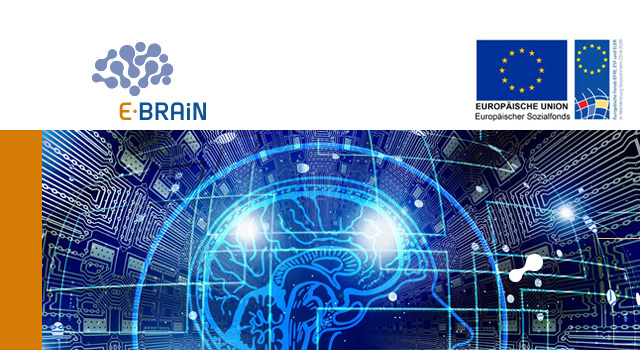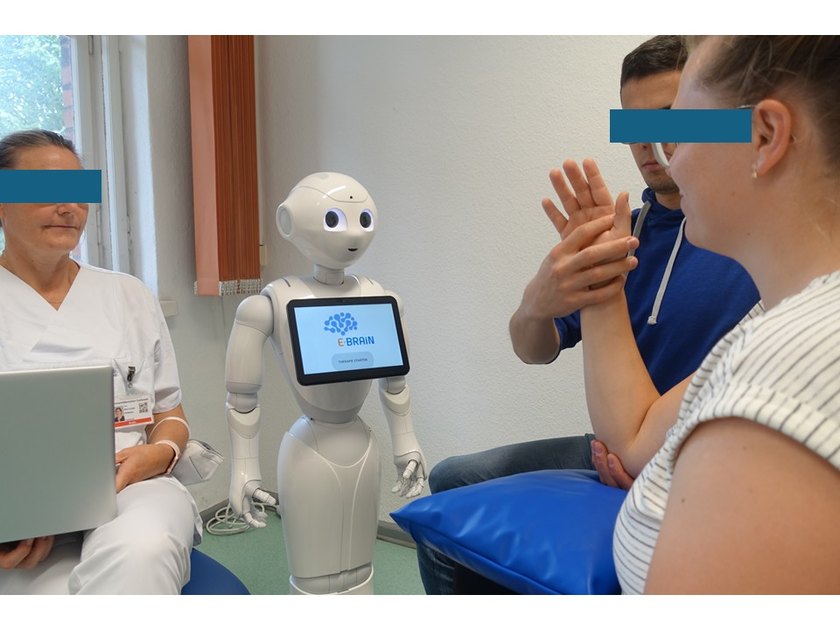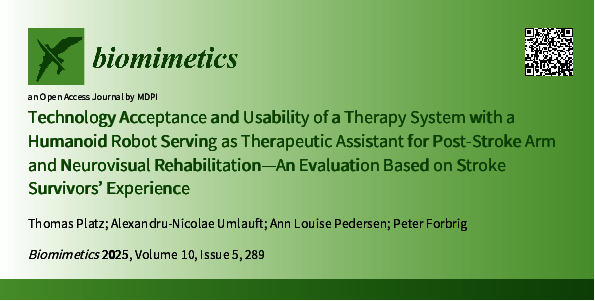
2025-01 E-BRAiN News – Technology acceptance study
Stroke survivors consider technology as very acceptable
Stroke survivors need intensive training that can be supported by a humanoid robot
After brain damage with the increased endogenous plasticity of the brain, it is possible to at least partially restore brain and thus body functions through targeted interventions (‘neural repair therapy’) (Joy and Carmichael, 2021).
Such therapies can be successful if they are specifically and comprehensively designed for the damaged bodily function, are carried out at the individual's performance limit with sufficient intensity and sufficient dose and the necessary commitment to training can be provided by those affected through sufficient motivation.
Impairment-oriented training pursues precisely this approach (Platz, 2004; Platz & Lotze, 2018). The specific and comprehensive treatment approach has been shown to lead to a more pronounced functional recovery than other therapies with the same dosage over the same period of time (Platz et al., 2009).
However, the implementation of function-restoring therapy is limited in practice due to therapeutic resource constraints, which will become even more acute due to the foreseeable increase in the number of people affected by stroke in societies worldwide and the fact that no corresponding increase in the number of specialised therapists can be expected (Knecht et al., 2023).
An important approach here is the digital implementation of functionally restorative therapy for stroke patients.
The use of humanoid robot technology helps to fulfil the need for a social counterpart in therapy (Feingold-Polak et al., 2024), thereby supporting the execution and implementation of intensive training lasting several weeks.
For these reasons, humanoid robotic technology was used in the E-BRAiN research network and damage-orientated therapy with basic arm training and arm ability training as well as mirror therapy for the treatment of arm paresis and multimodal therapy for visual neglect were implemented.
Figure 1 - Therapeutic situation with E-BRAiN - during an Arm-Basis-Training session

Figure from the original publication (Platz et al., 2025): The patient and caregiver both receive therapeutic instructions from the humanoid robot. The person in the background is not involved in the therapy.
Stroke survivors who trained with the system took part in a standardised survey, the results of which have now been published.
Using a questionnaire, a standardised investigation of technology acceptance was carried out in relation to various aspects that determine whether a technology is acceptable.
The aspects surveyed included: the subjectively experienced and evaluated usefulness, the user-friendliness, the adaptability of the system, whether it is a pleasure to work with the system, whether it can be trusted or whether it instils fear and whether it is experienced as a positive social counterpart (Heerink et al., 2010).
Eleven stroke stroke survivors, who themselves trained daily for two weeks under the guidance of the humanoid robot, took part in the questionnaire survey.
Overall, a high level of acceptance of the technology was documented (mean value 4.0, 95% confidence interval 3.7 to 4.3) (values from 1 - lowest acceptance to 5 - highest acceptance, with a value of 3 as a neutral experience anchor) (Platz et al., 2025). A high level of acceptance also applied to the individual aspects analysed.
In addition, it was analysed whether the level of technology acceptance depended on patient characteristics such as age, gender, time post-stroke, the syndrome treated, i.e. arm paresis or visual neglect, the severity of stroke sequelae in terms of neurological symptoms and disability in daily living. This was not the case. The level of technology acceptance was high regardless of these patient characteristics.
The positive results are attributed to the fact that the development of the system was user-centred, takes into account important concepts of professional and human care in rehabilitative therapy, offers and implements therapy procedures that have a high chance of individual treatment success and uses a humanoid robot as a social counterpart.
Figure 2 - Banner of the original manuscript (Open Access)

Reference / source
Platz T, Umlauft A-N, Pedersen AL, Forbrig P. Technology Acceptance and Usability of a Therapy System with a Humanoid Robot Serving as Therapeutic Assistant for Post-Stroke Arm and Neurovisual Rehabilitation—An Evaluation Based on Stroke Survivors’ Experience. Biomimetics. 2025; 10(5):289. https://doi.org/10.3390/biomimetics10050289
A research association of the University and University Medicine Greifswald, the University of Rostock and the Neubrandenburg University of Applied Sciences
Network Coordinator Prof. Dr. med. Thomas Platz | Ansprechpartner Neurorehabilitation Working Group Team |
Legal notice | Privacy policy | Unsubscribe from newsletter
ebrain-science.de
